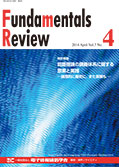Volume 7, Issue 4
Displaying 1-18 of 18 articles from this issue
- |<
- <
- 1
- >
- >|
Cover
-
2014 Volume 7 Issue 4 Pages 4_0
Published: 2014
Released on J-STAGE: April 01, 2014
Download PDF (5878K) -
2014 Volume 7 Issue 4 Pages 298
Published: April 01, 2014
Released on J-STAGE: April 01, 2014
Download PDF (122K)
Preface
-
2014 Volume 7 Issue 4 Pages 299-300
Published: April 01, 2014
Released on J-STAGE: April 01, 2014
Download PDF (392K)
Special Contribution
-
2014 Volume 7 Issue 4 Pages 301-307
Published: March 10, 2014
Released on J-STAGE: April 01, 2014
Download PDF (562K)
Review Papers
Proposed by R
-
2014 Volume 7 Issue 4 Pages 308-316
Published: April 01, 2014
Released on J-STAGE: April 01, 2014
Download PDF (1766K)
Proposed by MSS
-
2014 Volume 7 Issue 4 Pages 317-325
Published: February 19, 2014
Released on J-STAGE: April 01, 2014
Download PDF (2242K)
Proposed by TL
-
2014 Volume 7 Issue 4 Pages 326-335
Published: April 01, 2014
Released on J-STAGE: April 01, 2014
Download PDF (1661K)
Proposed by EA
-
2014 Volume 7 Issue 4 Pages 336-347
Published: April 01, 2014
Released on J-STAGE: April 01, 2014
Download PDF (4629K)
Proposed by Editorial Committee
-
2014 Volume 7 Issue 4 Pages 348-364
Published: April 02, 2014
Released on J-STAGE: April 02, 2014
Download PDF (7740K)
Miscellaneous Articles
ESS News
-
2014 Volume 7 Issue 4 Pages 365-367
Published: April 01, 2014
Released on J-STAGE: April 01, 2014
Download PDF (252K) -
2014 Volume 7 Issue 4 Pages 368
Published: April 01, 2014
Released on J-STAGE: April 01, 2014
Download PDF (193K)
International Conference Report
-
2014 Volume 7 Issue 4 Pages 369-372
Published: April 01, 2014
Released on J-STAGE: April 01, 2014
Download PDF (1533K) -
2014 Volume 7 Issue 4 Pages 372
Published: April 01, 2014
Released on J-STAGE: April 01, 2014
Download PDF (882K)
Let´s go to IEICE Workshops!
-
2014 Volume 7 Issue 4 Pages 373
Published: April 01, 2014
Released on J-STAGE: April 01, 2014
Download PDF (310K) -
2014 Volume 7 Issue 4 Pages 373b-375
Published: April 01, 2014
Released on J-STAGE: April 01, 2014
Download PDF (734K) -
2014 Volume 7 Issue 4 Pages 375
Published: April 01, 2014
Released on J-STAGE: April 01, 2014
Download PDF (285K)
Winners´ Voice
-
2014 Volume 7 Issue 4 Pages 376-383
Published: April 01, 2014
Released on J-STAGE: April 01, 2014
Download PDF (3620K)
Committees & Editors Notes
-
2014 Volume 7 Issue 4 Pages 384-386
Published: April 01, 2014
Released on J-STAGE: April 01, 2014
Download PDF (382K)
- |<
- <
- 1
- >
- >|
